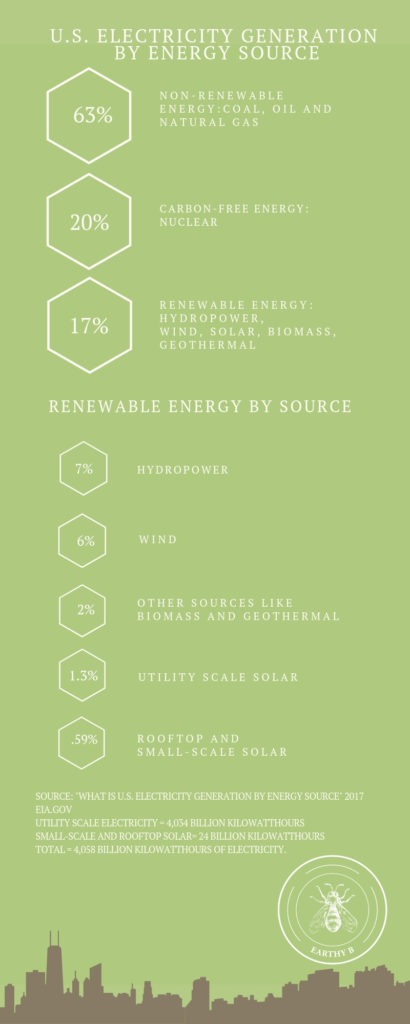What an amazing world we live in. We can turn on the lights with the flip of a switch. We have the power to run our computers, dishwashers and the heat all at once and we rarely question where that power comes from. But as we become more aware of climate change, we know the main source of that power is hurting our one planet. Fossil fuels have been a leading source of energy for years, but scientists around the world are asking us to phase them out for clean and renewable energy sources.
In total, renewable energy is still only about 17% of total electricity generation in the US. Fossil fuels like coal, oil and natural gas are 63%. Wind power is about 7%, and solar power is only about 2% in the US. There’s more to clean and renewable energy than solar and wind, so below are the main sources in the United States.
Hydropower
Hydropower produces energy from falling or fast-running water from dams, waterfalls, and rivers. Hydroelectricity is a renewable energy source. However, the dams created to capture hydroelectricity often negatively affect local eco-systems.
Hydropower generated 7.4% of the electricity in the United States in 2017. One example of hydropower comes from Washington State where 75% of the state’s electricity came from The Grand Coulee Dam on the Columbia River.
Wind power
Wind turbines produced 6.3% of electricity in the United States in 2017. Most wind power came from a few states like Texas, Iowa, and California.
Onshore wind power could produce 21.6% of the world’s electricity by 2050, according to Drawdown.org.
Offshore wind power could generate 4%, of the world’s electricity by 2050 according to Drawdown.org.
Solar Energy
Utility-scale solar energy produced 1.3% of U.S. electricity in 2017, which is about 53 billion kWh of electricity.
Rooftop and small-scale solar systems produced .59%, which is about 24 billion kWh of electricity in the U.S.
Utility-scale solar could become 10%, and rooftop solar 7% of total global electricity generation by 2050 according to Drawdown.org.
Biomass
Biomass like burning wood and landfill methane was about 1.6% of electricity in the US in 2017. Biomass is usually considered a regrettable alternative because using trees and landfills for energy isn’t exactly sustainable. But it doesn’t have to be that way.
Read: From flame-throwing robots to biomass & biochar to learn more.
Nuclear power
Nuclear energy was 20% of the electricity mix in the US in 2017. It does not contribute to climate change and is considered a carbon-free source of energy. Since renewable energy may not be able to generate 100% of the energy the world needs, prominent environmentalists and thought leaders have been speaking up about the role nuclear energy may need to play.
“Nuclear is ideal for dealing with climate
– Bill Gateschange, because it is the only carbon-free,scalable energy source that’s available 24 hours a day. The problems with today’s reactors, such as the risk of accidents, can be solved through innovation. The United States is uniquely suited to create these advances with its world-class scientists, entrepreneurs, and investment capital.”
Michael Shellenberger explains why we might need nuclear energy even though it’s not a “renewable” source of energy.
The future of renewable energy
Renewable energy can supply 80% of total U.S. electricity generation by 2050 according to the Renewable Electricity Futures Study by the Department of Energy’s National Renewable Energy Laboratory (NREL). However, the study also included nuclear, efficient natural gas, “clean coal”, and energy efficiency as part of that energy mix. Variable wind and solar photovoltaic generation would supply 50%. The report did not take into account new improvements in technology since 2010, but it did assume a more flexible electricity grid would be developed.
A more recent study interviewed 114 energy experts about the “12 great debates” surrounding the future of renewable energy. The study by the Renewable Energy Policy Network for the 21st Century[note]REN21, 2017, REN21 Renewables Global Futures Report (GFR)[/note] doesn’t offer conclusive answers about the future of renewable energy. However, it does show that even the experts aren’t in agreement about what the future will bring.

